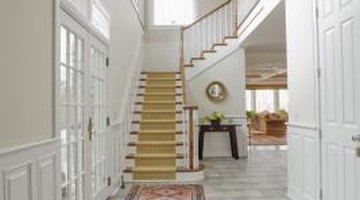Bullnose Trim Vs. Quarter Round Trim
Molding is a term used by builders and architects to describe a strip of material covering the transition from one surface to another. Flat trim and crown are both types of molding, as is strip trim, a category that includes bullnose and quarter round. Bullnose is most often, but not exclusively, associated with ceramic tile work. Quarter round, on the other hand, is most often associated with wood.
Bullnose Basics

Bullnose is a strip trim most often used in ceramic tile work to transition to a raised surface. If you look at tile superimposed on a wood floor, you will usually see a smoothly rounded ceramic edge — an example of bullnose trim. Bullnose trim can be used on parallel but uneven surfaces like the one just mentioned, or it can used to transition a perpendicular edge like the edge of a stair step or the corner of a wall.
90 and 180
Whether wood or ceramic, bullnose trim comes in two forms: 90 degree and 180 degree. The 90-degree trim has two flat sides meeting at a right angle, allowing it to be placed at edges and corners. The 180-degree bullnose trim has one flat side with a solid, equilateral ridge in the opposite direction of the flat edge. The 180-degree bullnose installs on flat surfaces to create a continuous ridge.
Rails
Some bullnose trim is wide and more elaborately shaped on the non-flat surface. In both wood and ceramic tile, this kind of bullnose trim is used to create fancy edges or rails. Tile work extending part way up a wall is often trimmed with the large, elaborately curved bullnose to make the transition from tile to drywall or wallpaper. In the same way, wood bullnose trim can be used to split a wall horizontally, such as with chair rails.
Quarter Round
Quarter round trim is, like 90-degree bullnose, a strip with two flat sides meeting at a right angle. Quarter round refers to wood molding that is generally flexible and used to cover gaps and conceal imperfections. Quarter round trim is commonly seen at the bottom of interior walls, where it hides the gap between uneven flooring and wall trim.
References
Writer Bio
Stanley Goff began writing in 1995. He has published four books: "Hideous Dream," "Full Spectrum Disorder," "Sex & War" and "Energy War," as well as articles, commentary and monographs online. Goff has a Bachelor of Arts in English from the University of the State of New York.
Photo Credits
- Jupiterimages/Creatas/Getty Images
More Articles



